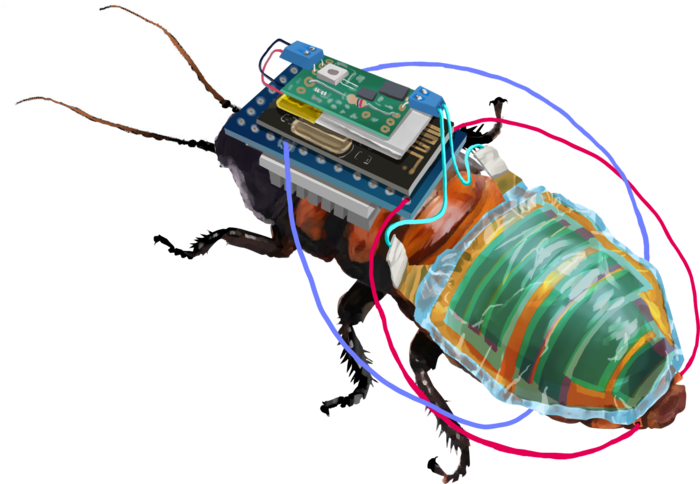A method for making remote controlled cyborg cockroaches has been developed by an international team led by scientists at the RIKEN Cluster for Pioneering Research (CPR). The system includes a tiny wireless control module that is powered by a rechargeable battery coupled to a solar cell.
 Researchers at RIKEN, Japan have created remote controlled cyborg cockroaches, equipped with a tiny wireless control module that is powered by a rechargeable battery attached to a solar cell. Image Credit: RIKEN
Researchers at RIKEN, Japan have created remote controlled cyborg cockroaches, equipped with a tiny wireless control module that is powered by a rechargeable battery attached to a solar cell. Image Credit: RIKEN
Despite the mechanical gadgets, the insects may move freely thanks to flexible materials and ultrathin electronics. These developments, which were published on September 5th, 2022, in the journal npj Flexible Electronics, will contribute to the widespread use of artificial insects.
To help investigate dangerous regions or monitor the environment, scientists have been attempting to create cyborg insects, which are partially insects and mostly machines. The ability to control cyborg insects remotely for extended periods of time is necessary for their use to be viable, though.
This necessitates cordless, rechargeable battery-powered control of their leg segments. Nobody wants a team of robotic cockroaches running about which are suddenly out of control, therefore keeping the battery fully charged is essential.
Although docking stations for charging the battery could be constructed, the requirement to return and recharge might interfere with missions that must be completed on schedule. To ensure that the battery is always charged, the ideal solution is to incorporate an on-board solar cell.
This is, however, easier said than done. The research group had to create a special backpack, ultrathin organic solar cell modules, and an adhesion system that keeps the machinery connected for extended periods of time while still permitting natural movements to successfully incorporate these devices onto a cockroach with limited surface area.
The team conducted research using 6 cm long Madagascar cockroaches under the direction of Kenjiro Fukuda, RIKEN CPR. They used a specially created backpack that was modeled on the body of a model cockroach to attach the wireless leg-control module and lithium polymer battery to the top of the bug on the thorax.
The hard electronic equipment was able to be securely attached to the thorax for more than a month thanks to the elastic polymer backpack, which was 3D printed and flawlessly contoured to the curved surface of the cockroach.
The dorsal side of the abdomen was mounted with the 0.004 mm thick organic solar cell module.
The body-mounted ultrathin organic solar cell module achieves a power output of 17.2 mW, which is more than 50 times larger than the power output of current state-of-the art energy harvesting devices on living insects.
Kenjiro Fukuda, RIKEN Cluster for Pioneering Research
Freedom of movement was made possible by the ultrathin and flexible organic solar cell, as well as how it was attached to the insect. The researchers discovered that the abdomen changes shape and parts of the exoskeleton overlap when they closely examined the motions of cockroaches in their natural environment.
They interspersed adhesive and non-adhesive regions onto the films to accommodate this, allowing the films to stretch while maintaining their bond. The cockroaches took twice as long to run the same distance when thicker solar cell films were tested, or when the films were uniformly attached. They also had trouble getting back up after falling.
The new cockroach cyborgs were evaluated after these parts, together with cables that stimulate the leg segments, were incorporated into the insects. Animals were induced to turn to the left and right using the wireless remote control after the battery had been charged for 30 minutes using simulated sunlight.
Considering the deformation of the thorax and abdomen during basic locomotion, a hybrid electronic system of rigid and flexible elements in the thorax and ultrasoft devices in the abdomen appears to be an effective design for cyborg cockroaches. Moreover, since abdominal deformation is not unique to cockroaches, our strategy can be adapted to other insects like beetles, or perhaps even flying insects like cicadas in the future.
Kenjiro Fukuda, RIKEN Cluster for Pioneering Research
Journal Reference
Kakei, Y., et al. (2022) Integration of body-mounted ultrasoft organic solar cell on cyborg insects with intact mobility. npj Flexible Electronics. doi.org/10.1038/s41528-022-00207-2.